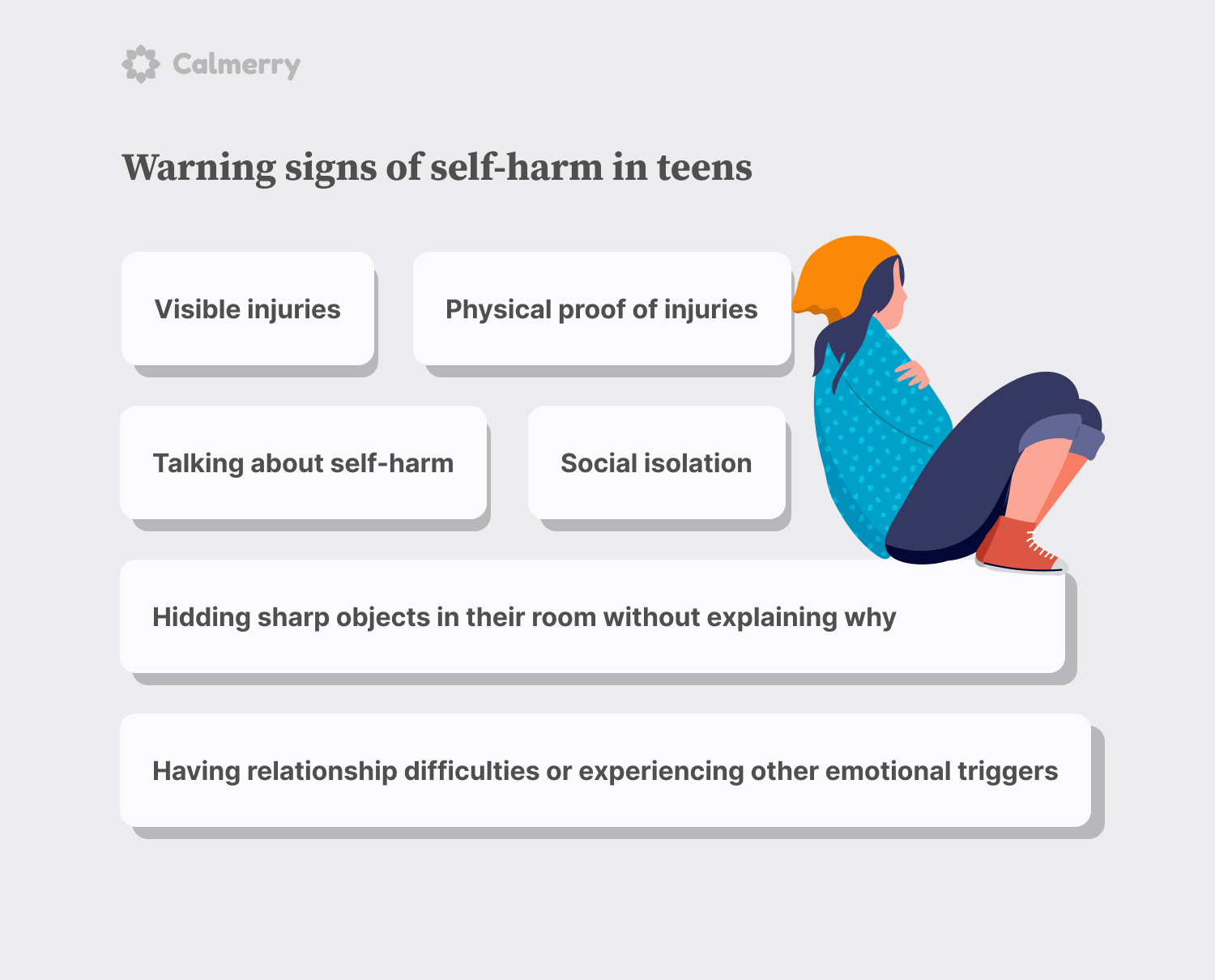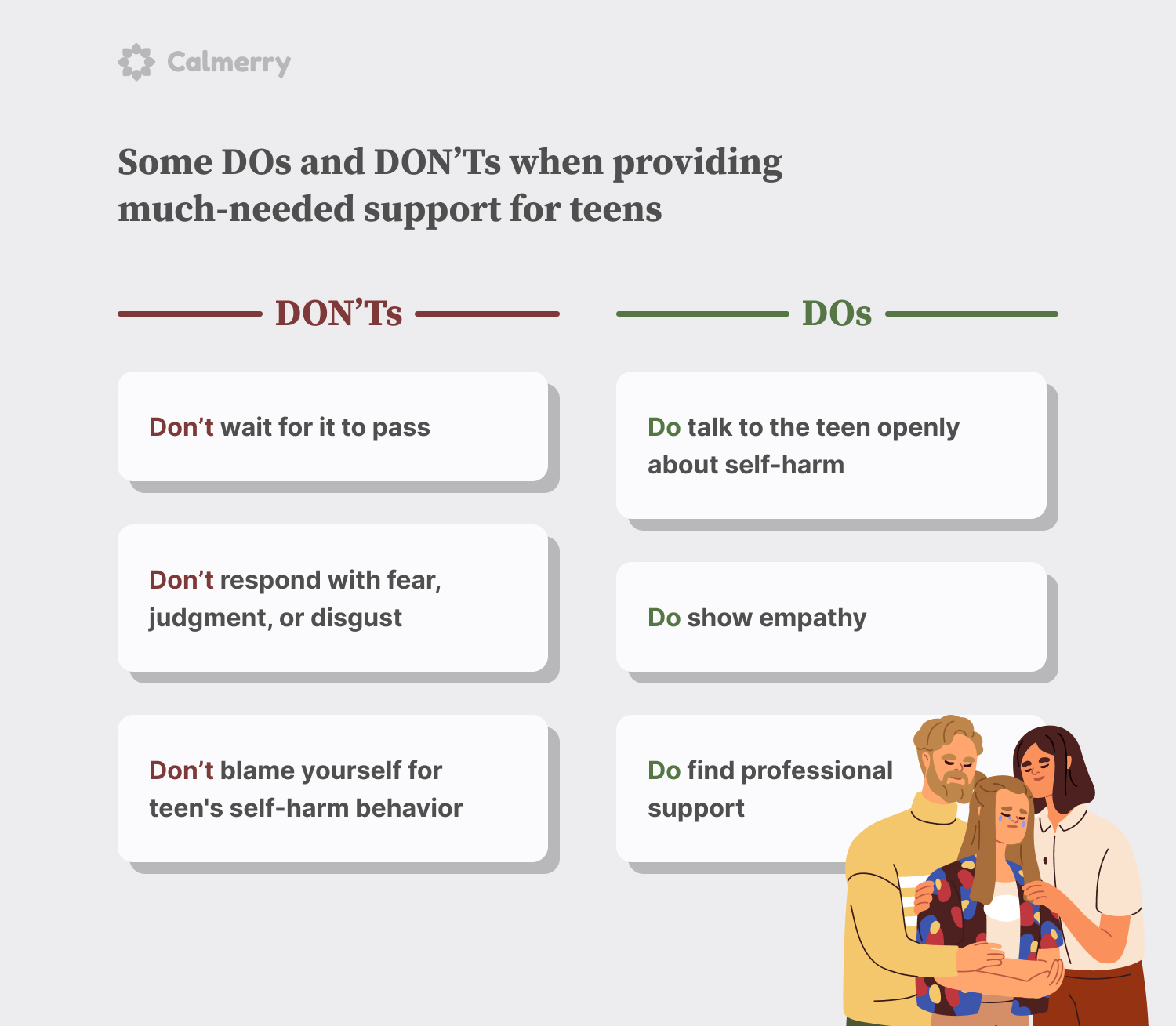When Children and Teens Self-Harm: What Parents Need to Know

In this article
Self-harm in teens is on the rise, and unfortunately, it doesn’t seem like it will go away any time soon. It’s terrifying for parents and other caring adults to realize that their teen is engaging in self-harm. It doesn’t help that teens’ self-harm is often misunderstood.
You might feel lost about why they would intentionally hurt themselves or worry that self-harming means that they will attempt suicide. But it’s critical that we, as adults, start to understand why kids sometimes self-harm and know how to support them when they do.
Read on to learn more about the causes and warning signs of self-harm in teenagers and how to support the teen who hurt themselves.
What is self-harm in teens?
Self-harm, also called non-suicidal self-injury or NSSI, is when someone intentionally hurts themselves and causes harm to their body, but not because they want to end their life. People of any age can self-harm.
However, it is more likely to be more common in young people. Recent surveys revealed that one in every three teenage girls engages in some type of self-harm. And even though self-harm is more common in teens, kids younger than 12 can self-harm, too.
Some common examples of ways kids might engage in self-harm include:
- The most common type of self-harm behavior is cutting (with a razor, knife, scissors, or other sharp objects)
- Biting, scratching and picking, burning their skin
- Pulling out hair
- Piercing
- Self-mutilation, like sticking objects into the body
- Banging head against the wall or other hard objects
Some mental health experts consider any type of behavior that intentionally or unintentionally harms oneself as “self-harm.” This behavior would include things like suicide attempts, unsafe sex, and excessive drug and alcohol use. But for the purposes of this article, when we talk about self-harm, we are referring specifically to non-suicidal self-injury.
Why do kids cut themselves?
When we see young people cutting themselves, we might automatically assume that they’re making a suicide attempt. But this isn’t the case for self-harm (non-suicidal self-injury). Kids who cut themselves and engage in other types of self-harm do so for many reasons, but not as a way to try to end their lives.
That isn’t to say that kids who self-harm can’t also feel suicidal. The two things are closely related – research shows that people who self-harm are over three times more likely to make a suicide attempt at some point in the future. And, very rarely, people will accidentally cut themselves too deep and end up dying.
But self-harm isn’t a suicide attempt in itself. It’s actually the opposite – a way to cope with painful feelings without resorting to suicide. To understand why a specific teen is self-harming, it’s best to ask them – their reasons may be unique. Some teens may not have a clear reason why they do it.
But, in general, some common reasons why kids and teens engage in self-harm include:
- To cope with painful or negative emotions
- To release emotional tension or pain
- To use physical pain to distract from emotional pain
- To punish themselves
- To feel alive
- To regain a sense of control over themselves or their lives
- To deal with numbness (feeling something is better than feeling nothing at all)
- As a result of peer pressure or social contagion (they hear of others doing it)
- As a result of intrusive thoughts
- As a cry for help
- Because they are addicted to it
Again, though, there is no single cause for self-harm. To understand the teen you’re worried about, talking to kids is important.
Warning signs of self-harm in teens
Teens may try to hide that they are self-harming, but often, there will be warning signs that let you know what’s happening. Some signs of self-harm in teens can include:

Visible injuries
Teens often self-harm by cutting, biting, scratching, or burning their skin. This will create scars and marks. If you notice unexplained injuries on the teen’s body, then this could be a sign that they’re self-harming.
Physical proof of injuries
Some teens will try to hide these marks. They may cover up with clothing – for example, by wearing long sleeves even on warm days. They may pull their sleeves down over their hands to hide their wrists. Or may cover their forearms with marker drawings or jewelry.
Social isolation
It’s normal for teens to want to spend more time with their peers than with their parents. But if the teen seems isolated from everyone – for example, they no longer see their close friends – that’s something important to pay attention to.
Talking about self-harm
This one seems obvious, but it’s worth stating – some teens who are self-harming will make their fascination with self-harm known. For example, they might follow self-harm accounts on social media or listen to music with themes of self-harm.
Hidding sharp objects in their room without explaining why
These objects could be used for cutting and other forms of self-harm.
Needing a lot more first aid supplies, like band-aids, than usual. Since self-harm is not suicidal behavior, teens will usually try to help themselves heal from any injuries that they may have inflicted on themselves.
Having relationship difficulties or experiencing other emotional triggers
If the teen has recently been through a breakup, had a fight with family or friends, has been the victim of bullying, or is facing any other stressful event, then this could drive them to self-harm – especially if they’ve done so before.
How to help teens who hurt themselves
If you notice any warning signs that a teen in your life is self-harming, it’s important to take action right away. Again, self-harm isn’t the same thing as a suicide attempt, so the teen is probably not trying to end their life.
It isn’t the self-harm that’s the core problem – it’s what it reflects. A teen who self-harms is probably going through a lot of emotional turmoil and pain, and they need support from significant ones. Here are some DOs and DON’Ts when providing that much-needed support.

Don’t wait for it to pass
There is a myth that self-harm is a “phase” that teens will grow out of, so there is no point in addressing it. Although some young people who self-harm do stop after their teenage years, that doesn’t mean they don’t need support and treatment to stop.
Research shows that teens who have trouble with stopping self-harm are more likely to attempt suicide in the future. On top of that, self-harm is typically a sign of a deeper mental health condition like depression. So it’s critical to address this behavior as soon as possible. It won’t disappear by itself.
Do talk to the teen openly about self-harm
It’s important not to wait for a teen to come to you if you notice indicators that they are self-harming. Approach them about it, and have an open conversation.
For example, you might say something like:
- “Hey, I want to talk to you about something. Are you not in trouble? I love you, and I want to support you.”
- “I noticed some cuts and scars on your arms the other day. I know self-harm is pretty common for people your age, so I wanted to check in with you to see how you’re feeling lately.”
- “Are you harming yourself? Please help me understand what you’re going through.”
Don’t respond with fear, judgment, or disgust
Finding out that someone you love is self-harming can be terrifying. But when kids tell you about it, better to avoid responding with any fear or disgust. Your first instinct might be to ask, “Why would you do this to yourself?”. But this type of response will only make the teen feel judged.
Listen openly and empathetically. Ask open questions and show genuine curiosity about how the teen feels and what has led them to self-harm.
As a side note, it’s also important to avoid blaming yourself. This is no one’s fault. The important thing is that the teen is suffering and needs you now.
Do show empathy
Empathy is the ability to take another person’s perspective and see that perspective as valid. Consider the world through the teen’s eyes. Understand that it’s a big deal to them. Show empathy for the emotional pain they’re going through without brushing it off or minimizing it.
Reflect on what the teen might be feeling and experiencing. For example, you might say, “You’re feeling devastated that you and your boyfriend broke up. I hear you. Breakups are so painful. It can start to feel like the pain will never go away.”
Do find professional support
Lastly, it’s important to help connect the teen to professional mental health support. This may look different depending on your relationship with the teen, e.g., you’re their parent or a supportive adult in the community.
But the crucial thing to remember is that the teen needs professional support, like mental health therapy – to heal from the self-harming behavior and whatever painful emotions have led to it.
Having a teen who is self-harming is a stressful and painful experience, and you may need therapy to help you cope. If you’re looking for therapy to support yourself, we can help. Calmerry matches you to quality online therapists that fit you best.
online therapy
live video session



